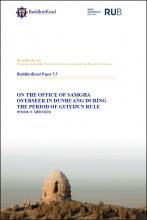BuddhistRoadPaper 5.5 “On the Office of Saṃgha Overseer in Dunhuang during the Period of Guiyijun Rule"
Synopsis
This essay focuses on the succession of important monks who occupied the prestigious post of saṃgha overseer (Chin. sengtong 僧統) in Dunhuang after the establishment of the Guiyijun regime (851–1036, Return-to-Allegiance Army, 歸義軍) in the territory from the second half of the 9th century until well into the 11th century. I look at the functions that were formally part of the jurisdiction and duty of the saṃgha overseers and, after that, at the lives of each of these monks. These are being examined against the data yielded by the primary sources, that is, the Dunhuang manuscripts. The overall purpose is to develop a sense of the institution of saṃgha overseer in Dunhuang and to arrive at a deeper appreciation of these monks as primary agents in the religious and political context of this minor kingdom located in Eastern Central Asia on the western-most border of the Chinese cultural space.
Chinese Translation
本文着眼于9世纪下半叶到11世纪敦煌归义军建立政权 (851–1036) 后, 历任在敦煌担任显赫僧统职位的重要僧人. 笔者根据收集, 整理敦煌写本中的记载, 梳理了僧统一般的管辖权和职能, 并进一步探究了每一任僧统的生平. 总体而言, 笔者想要对敦煌的寺院僧统机构有所了解, 进而对这些僧侣作为这个位于中亚东部, 中原文化西陲的小王国的宗教和政治环境中的主要代理人有更深的认识.

Downloads
Published
Categories
License

This work is licensed under a Creative Commons Attribution-NonCommercial-NoDerivatives 4.0 International License.

